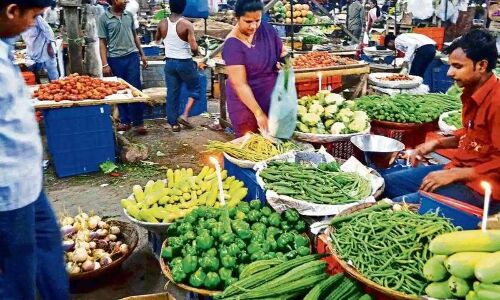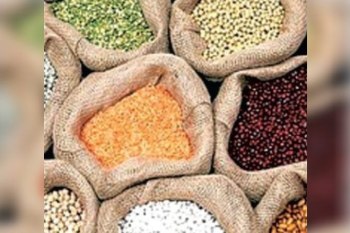Growing Concerns Over Food Inflation Intensify As Meager August Rains Disrupt Crucial Crop Growth
The convergence of irregular weather patterns as a direct outcome of climate change constitutes a looming disaster of immense proportions for our planet. The ripple effects extend far beyond immediate agricultural concerns, permeating various aspects of society and the environment. One of the most pressing concerns is the delicate and interconnectedness relationship between climate change and food security. With unpredictable weather events becoming more frequent and intense, the reliability of traditional farming methods diminishes. This instability in crop yields disrupts the delicate balance between supply and demand, often leading to food shortages, price volatility, and food inflation.

Concern Over Food Inflation
Amidst the halfway mark of the monsoon season, an exceedingly dry August has raised alarms about the prospects of essential kharif crops like arhar/tur, soybean, cotton, maize, bajra, and onions. This surge in food inflation, which swelled to 11.51% in July from 4.49% in June, is attributed to the dry conditions.
With rainfall deficiency reaching up to 40%, the arid weather patterns are expected to persist into September, extending the period of concern, as stated by experts.

“August witnessed a highly deficient rainfall, and this parched spell is anticipated to continue into September, at least for the initial days of the month,” remarked GP Sharma, the president of the private meteorological company Skymet.
The IMD (India Meteorological Department) forecasts that between August 30 and September 6, rainfall is likely to remain below average for most regions across the country except for the northeastern, eastern, and adjoining central parts of India.
Given that numerous kharif crops are in need of precipitation, this prolonged dry spell could have negative implications for their growth. Dharmakirti Joshi, the chief economist at the ratings agency Crisil, stated,
“Over the last month and a half, the risk of inflation has risen. The focal point is food inflation, which poses the most significant threat to overall inflation. If the dry conditions that prevailed in August persist, there’s potential for an increase in food inflation.” Joshi suggested that enhancing supplies would be the primary countermeasure.
“Nevertheless, government interventions to bolster supplies would mitigate the risk. Core and fuel inflation are anticipated to remain moderate. We foresee a balanced inflation risk at 5.5%, which aligns with our projection for inflation in the current fiscal year,” Joshi added.

India has been actively importing pulses and cooking oils to enhance domestic supplies while also suspending rice and wheat exports.
Maharashtra, the leading producer of onions, arhar, and sugar, and the second-largest producer of soybean, cotton, and significant quantities of maize and jowar, is grappling with over 40% of its revenue circles experiencing a drought of more than 15 days. Within this 40%, 15% have endured over three weeks without rainfall.
Chief Minister Eknath Shinde has called for prudent utilization of reservoir waters due to their levels being about 20% lower than the previous year.
The sowing of kharif onions, commonly known as red onions, has also been delayed in Maharashtra, which stands as the country’s primary onion-producing state.
Bharat Dighole, the chairman of the Onion Growers’ Association of Maharashtra, voiced, “Nurseries are ready, but due to the lack of rainfall, farmers are unable to transplant the seedlings in districts like Nashik, Ahmednagar, Pune, Solapur, Beed, etc.” Dighole, who is also leading the protest against a 40% export duty on onions, highlighted the predicament.
The repercussions of irregular rainfall are anticipated to reverberate across multiple states. While the IMD forecasts normal rainfall for the latter part of the monsoon season (August-September), even considering August’s deficit, some states, including Kerala, Bihar, Jharkhand, West Bengal, and Eastern Uttar Pradesh, are unlikely to recover from the substantial rainfall deficiency.

The Direct Relation Between Climate Change And Food Inflation
The erratic weather patterns observed, which are increasingly attributed to the impacts of climate change, are casting a looming shadow of disaster over the world.
These patterns directly affect agricultural productivity, creating significant challenges in cultivating essential food resources. As the frequency of extreme weather events rises, including droughts, floods, and unseasonal rains, the task of growing enough food to sustain the global population becomes equally more arduous.
The interconnectedness of climate change and its repercussions on food production paints a dire picture for millions of people around the world who depend on consistent harvests. The unpredictable shifts in temperature and precipitation are disrupting traditional growing seasons and causing crop failures. Consequently, these factors contribute to food scarcity, price hikes, and increased vulnerability for communities that rely heavily on agriculture.
Communities reliant on agriculture for their livelihoods find themselves in a precarious position, facing diminished incomes and increased susceptibility to poverty. The migration of farmers from rural to urban areas in search of better opportunities amplifies challenges in urban planning, employment generation, and social integration.
In addition to the immediate impact on food security, the broader consequences of these changes reverberate across economies, ecosystems, and social stability.
Farmers are now facing mounting challenges as they grapple with shifting climatic conditions, often requiring adaptation to new practices and crop varieties. The vulnerability of agricultural supply chains is becoming starkly evident as extreme weather events are disrupting distribution networks and leading to further shortages.

The Heavy Toll
Furthermore, the environmental toll of erratic weather patterns cannot be underestimated any longer. Ecosystems are strained as they attempt to adapt to rapid shifts in climate conditions.
What has further heightened the challenge is the biodiversity loss, deforestation, and soil degradation, a must for sustaining agricultural productivity in the long run. This, in turn, has threatened the ecosystems that provide us with critical services such as pollination, water purification, and climate regulation.
Are We Ready
As we are in the midst of witnessing the changing weather patterns right before our eyes, it is time to act, and we must act fast.
Governments, industries, and individuals must collectively implement comprehensive climate mitigation strategies.
Transitioning to renewable energy sources, promoting sustainable land management practices, and rethinking consumption patterns are imperative.
Equally crucial is the need for international cooperation. Climate change knows no borders, and its impacts are felt globally.
The Last Bit, Ultimately, the impending disaster of climate-induced food scarcity is a call to action for humanity. It necessitates a paradigm shift in our relationship with the planet, emphasizing sustainability, resilience, and compassion.
By acknowledging the interconnectedness of climate change, food security, and social stability, we can chart a more sustainable course that ensures millions of mouths are fed, ecosystems are protected, and our collective future is safeguarded.




